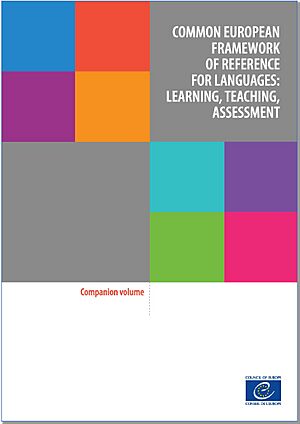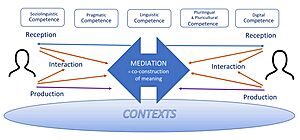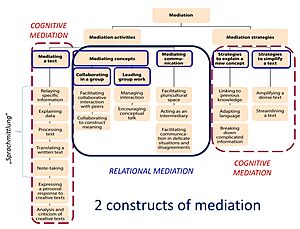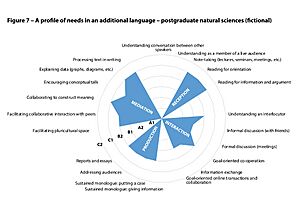Common European Framework of Reference for Languages facts for kids
Have you ever wondered how good you are at a foreign language? The Common European Framework of Reference for Languages, often shortened to CEFR, is a special guide that helps you understand your language skills. Think of it like levels in a video game, but for learning languages like Spanish, French, or German!
The CEFR was created by the Council of Europe to have one clear system for all languages in Europe. It helps schools, universities, and jobs understand how well someone can use a language. Today, it's used not just in Europe but all over the world.
The framework has six main levels: A1, A2, B1, B2, C1, and C2. These levels describe what you can do in a language, from introducing yourself (A1) to understanding almost everything (C2).
Contents
Why Was the CEFR Created?
In the late 1980s and 1990s, leaders in Europe wanted to make it easier for people to study, work, and travel between different countries. But there was a problem: how could a company in France know how good a person's French was if their certificate was from Germany?
To solve this, the Council of Europe created the CEFR. The goal was to have a single, trusted standard that everyone could use. This way, a "B2" in Spanish would mean the same thing everywhere. It helps teachers teach better and gives learners clear goals to aim for.
What Are the Six Levels?
The CEFR is divided into three main groups, each with two levels.
A Levels: Basic User
This is where everyone starts their language journey.
A1: Beginner
At this level, you can:
- Introduce yourself and others.
- Ask and answer simple personal questions, like where you live.
- Understand very basic phrases if people speak slowly and clearly.
A2: Elementary
At this level, you can:
- Talk about your family, your school, and your hobbies.
- Handle simple, everyday tasks like ordering food or asking for directions.
- Understand common sentences about familiar topics.
B Levels: Independent User
You can use the language on your own in most situations.
B1: Intermediate
At this level, you can:
- Deal with most situations that come up while traveling.
- Write simple texts about topics you're interested in.
- Describe your experiences, dreams, and opinions.
B2: Upper Intermediate
At this level, you can:
- Understand the main ideas of complex texts, like news articles.
- Have a normal conversation with native speakers without too much trouble.
- Explain your viewpoint on a topic, giving advantages and disadvantages.
C Levels: Proficient User
You have a high level of skill and can use the language with ease.
C1: Advanced
At this level, you can:
- Understand a wide range of long and difficult texts.
- Express your ideas fluently and without searching for words.
- Use the language for school, work, and social situations effectively.
C2: Mastery
This is the highest level. At this level, you can:
- Understand almost everything you hear or read with ease.
- Summarize information from different sources and present it clearly.
- Express yourself very fluently and precisely, even in complex situations.
What Skills Does the CEFR Measure?
The CEFR looks at how you use a language in real life. It focuses on four main skills:
- Reception: This is about understanding. It includes listening to someone speak and reading a text.
- Production: This is about creating language. It includes speaking (like giving a presentation) and writing (like sending an email).
- Interaction: This is about using language with other people. It means having a conversation where you both listen and speak.
The CEFR also considers where you use the language. For example, the way you talk to your friends (personal domain) is different from how you would write a school project (educational domain).
How Long Does It Take to Learn a Language?
How long does it take to reach a certain level? It depends on many things, but some language schools have made estimates. The table below shows the estimated number of study hours it might take for an English speaker to reach each level in German and French.
| Language | Estimated Study Hours to Reach Each Level | |||||
|---|---|---|---|---|---|---|
| A1 | A2 | B1 | B2 | C1 | C2 | |
| German | 60–150 | 150–260 | 260–490 | 450–600 | 600–750 | 750+ |
| French | 60–100 | 160–200 | 360–400 | 560–650 | 810–950 | 1,060–1,200 |
The CEFR Around the World
The CEFR started in Europe, but now it's used in many countries worldwide, including Canada, Japan, and Malaysia. It helps create a global standard for language learning.
However, some places have their own systems. For example, in the United States, many schools use the ACTFL Proficiency Guidelines. The levels have different names, but they can be compared to the CEFR. Many official language tests are linked to the CEFR levels. For example, if you take a Cambridge Assessment English exam for English or a DELF exam for French, your score will tell you which CEFR level you have reached.
An Update: The CEFR Companion Volume
In 2020, the Council of Europe released an update called the CEFR Companion Volume. It didn't replace the original, but added new ideas and made some improvements based on how we use languages today.
A New Focus on "Mediation"
The update introduced a bigger idea of mediation. This isn't just about translating. It's about acting as a bridge between people to help them understand each other.
Examples of mediation include:
- Explaining a graph or chart to someone.
- Taking notes in a group project to help everyone stay organized.
- Helping two friends who are having a misunderstanding to see each other's point of view.
It focuses on using language to work together and share knowledge.
No More "Native Speaker" Goal
The original CEFR sometimes compared learners to "native speakers." The new Companion Volume removed this idea. The goal is not to sound exactly like someone who grew up with the language. Instead, the goal is to be an effective and clear communicator. It's about being understood and expressing your ideas well, even if you have an accent.
Your Own Language Profile
The update also makes it clear that you don't just have one single level. You can have a profile of different skills. For example, you might be a B2 in reading because you love reading books in English, but a B1 in speaking because you don't get as much practice. This is completely normal! The CEFR helps you see where you are strong and where you can improve.
See also
- Assessment of basic language and learning skills
- European Day of Languages (26 September)
- ILR scale (Interagency Language Roundtable scale)
- List of language proficiency tests
- Task-based language teaching





